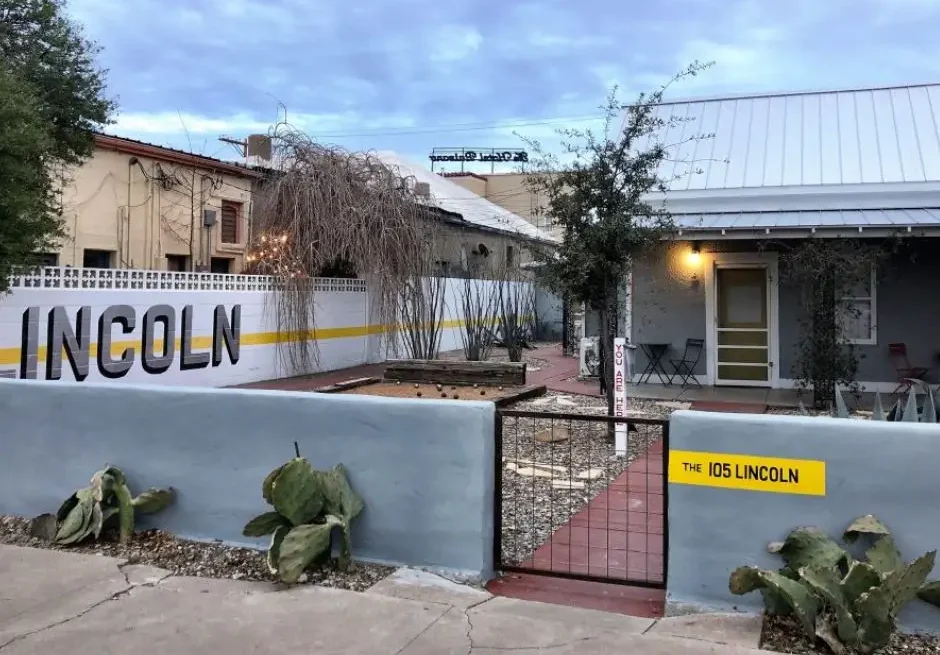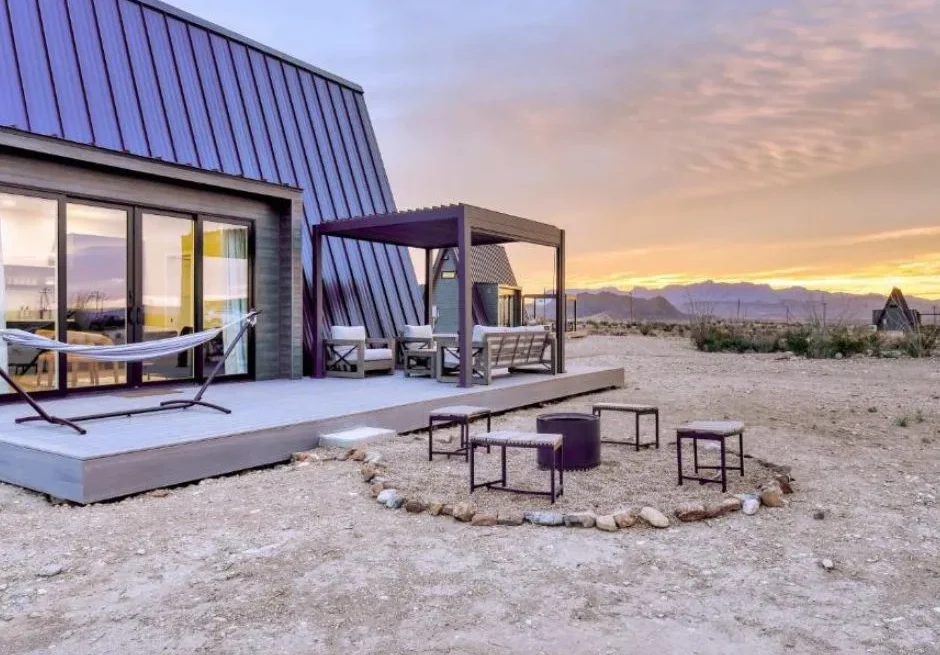You are standing in the Texas desert.
The night is still. The air feels cool against your skin.
Then it happens.
Tiny orbs of light blink in the distance — glowing red, white, and yellow. They hover above the horizon. They split, fade, then reappear miles away. Sometimes they dance. Sometimes they just hang there, pulsing softly like living stars.
That’s the Marfa Lights, one of the most enduring mysteries in the American Southwest.
People have been watching these strange desert glows for more than a century. Some swear they’re ghost lanterns. Others say science already explained them. Either way, when you see them for yourself, logic fades a little.
Out here, under the vast West Texas sky, mystery still feels possible.
A Quick Look at the Marfa Lights
Locals call them the Marfa Lights or the mystery lights of Marfa. You can see them from the official Marfa Lights Viewing Area, about nine miles east of town along Highway 90 toward Alpine.

The setup is simple — a large roadside lot with binoculars, benches, and open views across the desert plain. On clear nights, you’ll often find clusters of travelers sitting quietly, waiting for the show to start.
There’s no admission fee. No schedule. Just patience and a bit of luck.
The best times to visit? Fall through early spring, when the nights are cool and skies stay crystal clear. The Marfa Lights Festival, held every September, draws big crowds for live music, food, and the chance to spot those flickering orbs firsthand.
If you visit then, expect the viewing area to buzz with energy and curiosity.
A Bit of History
The mystery goes back to the 1880s.
Early ranchers and travelers reported seeing glowing balls of light near Mitchell Flat, just outside town. They thought they might be campfires or Apache signal fires. But when they rode closer, the lights vanished.
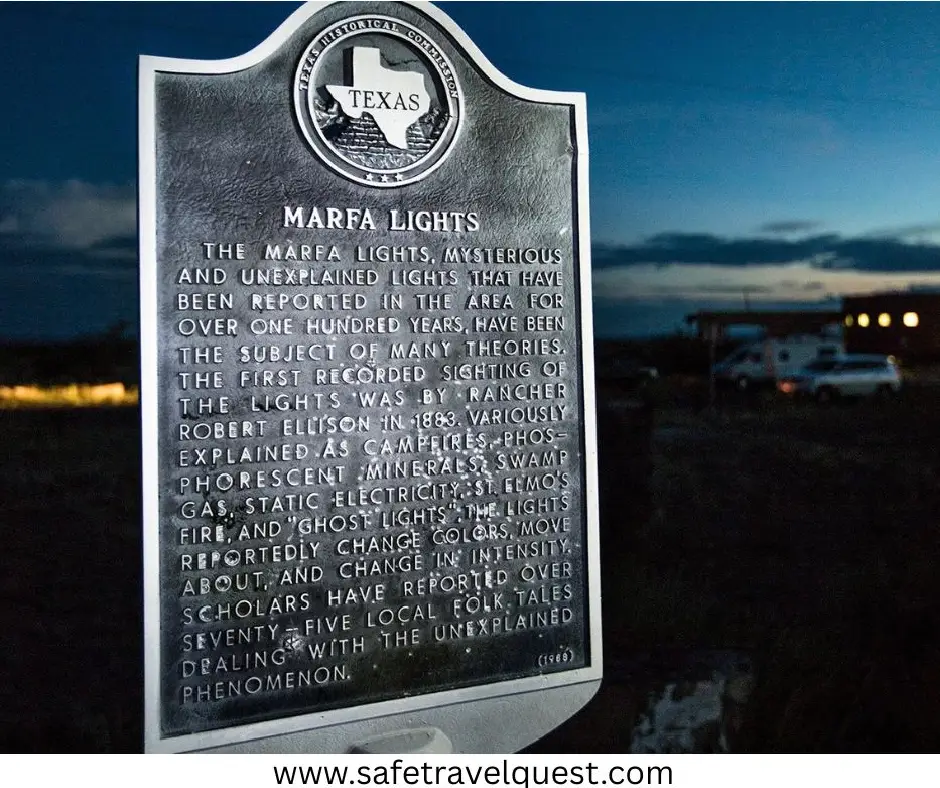
Local cowboy Robert Reed Ellison wrote about them in 1883, describing “dancing lights” that moved too fast and too far apart to be manmade.
Through the decades, stories grew. Pilots spotted them from the air. Drivers pulled over to stare. Photographers tried to catch them on film, only to end up with blank frames.
By the mid-20th century, the lights had become part of Marfa’s folklore — strange, stubborn, and impossible to pin down.
Even Native American tales from this region mention “ghost fires” that guided or warned travelers in the desert. The lights carried meaning long before science arrived to measure them.
And maybe that’s why they still capture the imagination.
Science Tries to Explain It
Of course, people have tried to solve the mystery.
One popular theory says the lights are just car headlights from Highway 67, about 30 miles away. When conditions are right — clear air, specific humidity, and layers of warm and cool air — the headlights reflect and bend, creating the illusion of floating orbs.
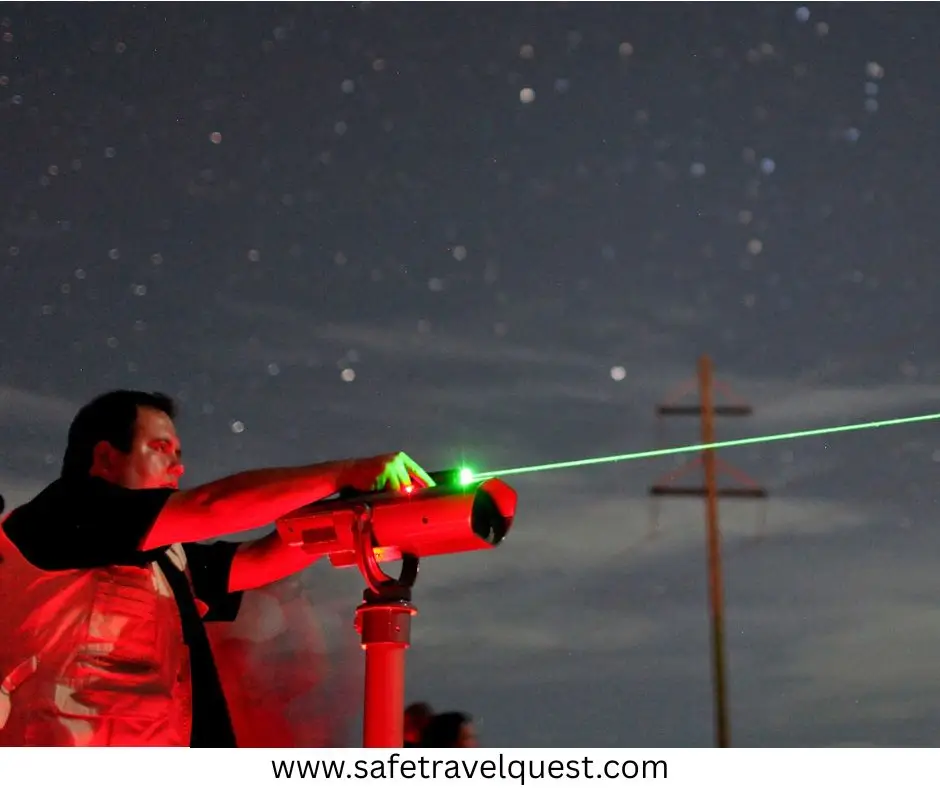
This idea gained traction after a 2004 study by physics students from the University of Texas at Dallas. They monitored the area for several nights and tracked the lights using maps and binoculars. Every time they saw the glow, a car appeared on a corresponding section of the highway.
Case closed? Not quite.
Some locals argue that the lights appeared long before cars existed. Others say not all sightings line up with traffic. There are still nights when no vehicles pass, yet the lights show up anyway — silent, distant, and unexplainable.
Other theories suggest mirages, electrical discharges, or atmospheric reflections — natural tricks of light caused by layers of hot and cool air over the desert.
But none of those fully capture the way the lights move. Or why they appear in clusters. Or why they sometimes flash in colors rarely seen in natural phenomena.
So the debate continues.
Science has its answers. Locals have their stories. The desert keeps its secrets.
Folklore, Pride, and Pop Culture
In Marfa, the lights are more than a mystery. They’re part of the town’s identity.
Every September, locals celebrate the Marfa Lights Festival — a three-day event filled with live bands, food trucks, and parades. The festival started in 1986 and has become a beloved annual tradition.
You’ll see handmade lanterns, neon art, and families spread out on blankets near the viewing area, all watching the horizon for that familiar flicker.
The lights have appeared in documentaries, TV shows, and movies. Even the X-Files once hinted at them. They’ve been referenced in songs, travel essays, and late-night road-trip stories whispered between friends.
Some folks call them UFOs. Others think they’re spirits of lost travelers or reflections of desert energy.
Whatever the theory, everyone agrees on one thing: once you’ve seen the Marfa Lights, you don’t forget them.
Seeing the Lights for Yourself
Getting to the Marfa Lights Viewing Area is easy.
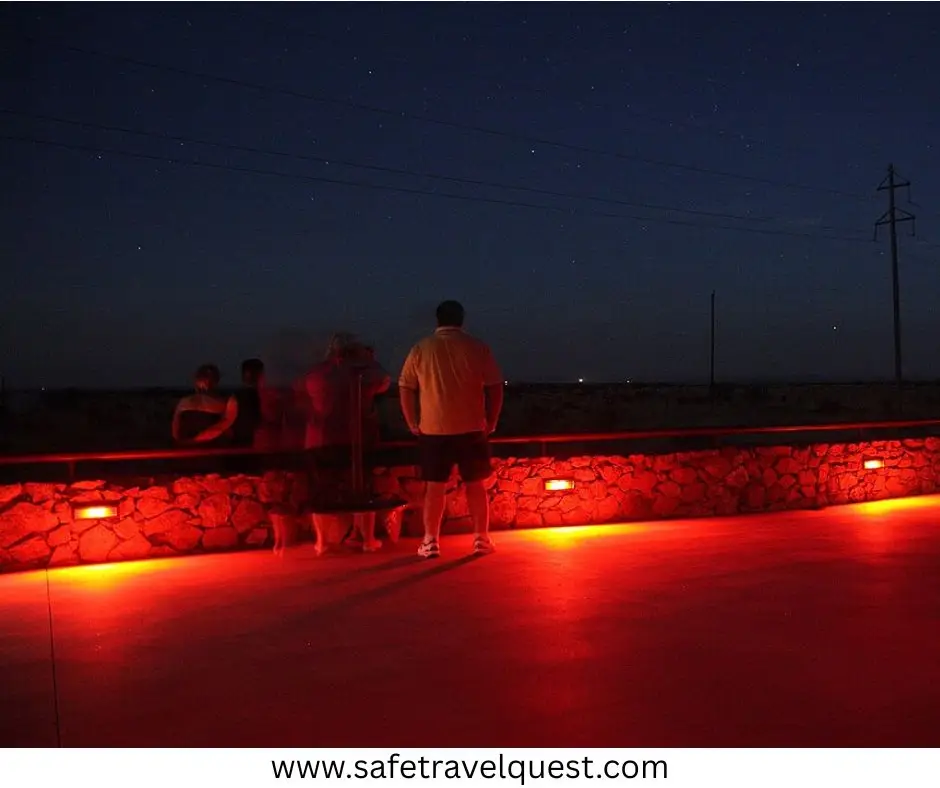
From downtown Marfa, drive east on Highway 90 for about nine miles. You’ll see a large rest stop-style area on the right, marked by a sign and a small stone pavilion.
The spot overlooks Mitchell Flat, the wide desert basin where most sightings occur. It’s open 24 hours a day, year-round, and there’s no charge to visit.
Arrive around sunset to catch the full transition from day to night. The desert sky glows pink and gold, then deepens to black as stars spill across the horizon. The anticipation builds quietly — conversations fade, cameras come out, and everyone faces the same direction.
Then someone gasps. A small light appears far out in the dark.
It moves, stops, then disappears.
Moments later, another glows beside it. Then two more.
The crowd murmurs. The desert hums. The mystery unfolds.
Sometimes the lights show up for minutes. Other nights, not at all. That’s part of the thrill — no one can predict it.
It’s a waiting game wrapped in wonder.
What to Bring
The desert looks gentle, but it’s rugged. A little preparation goes a long way.
- Jacket: Evenings can turn chilly, even in summer.
- Blanket or lawn chair: You’ll be sitting for a while, and the ground gets cold.
- Snacks and water: There are no vendors nearby, so pack your own.
- Camera or tripod: For long exposures, if you want to try capturing the lights.
- Binoculars: They help spot distant flashes early.
- Bug spray: Mosquitoes appear when the wind drops.
And most importantly — patience. The lights don’t run on schedule.
Insider Tips
Want to improve your odds of seeing the Marfa Lights? Here are a few quick insights from locals and frequent visitors:
- Avoid bright headlights or phone lights. Let your eyes adjust to the dark. Light pollution kills the magic.
- Go on clear nights. Cloud cover hides the horizon completely.
- Skip full moons. The brightness can drown out subtle glows.
- Visit on weekdays. Fewer crowds mean a quieter, more peaceful experience.
- Combine stops. See the Chinati Foundation, Prada Marfa, or Planet Marfa during the day, then head to the viewing area at night.
- Stay overnight in Marfa. Watching the lights late means you’ll want a cozy bed afterward — try one of the town’s boutique motels or glamping spots like El Cosmico.
The best shows often happen between 9 p.m. and midnight, especially when the desert air is cool and still.
Read More:Top 5 Things to do in Marfa Texas and Travel Guide
Read More : 10 Best Bars in Marfa Texas for Craft Cocktails & Desert Nights
Local Voices
Ask anyone in town about the lights, and you’ll get a story.
One shop owner told me, “I’ve lived here 40 years, and I still can’t explain them. But they make this place feel alive.”
Another laughed and said, “Tourists come for art. They stay for the lights. Half the time, they see them. The other half, the desert’s just teasing.”
For locals, the lights aren’t just unexplained; they’re a reminder that not everything needs an answer. They add a shimmer of magic to daily life — a shared mystery that belongs to everyone who’s ever looked out across the flat and seen the desert glow back.
What Do They Look Like, Really?
Descriptions vary. Some people see glowing orbs — red, orange, white. Others describe them as bright flashes or flickers that dart quickly across the horizon.
Sometimes they move in pairs, like headlights weaving through air. Other times they hover silently, far apart, fading and reappearing like fireflies trapped in glass.
You never know what you’ll see.
That uncertainty is what keeps people coming back. Even skeptics admit the view itself — a black desert sky full of stars — is worth the drive.
A Few Fun Facts
- NASA scientists have shown interest in the Marfa Lights, though no official study has solved them.
- The Texas Department of Transportation built the viewing area in 2003 to protect the roadside spot where people used to park.
- Photographers worldwide travel here for time-lapse footage. Many stay multiple nights just for one clear glimpse.
- Some nights, visitors hear soft humming or static before the lights appear — though that might just be the wind.
- The Marfa Lights Festival began in 1986 and still anchors the town’s event calendar.
Even when the lights don’t appear, the shared anticipation feels special. Strangers swap stories, laugh, and look toward the horizon together.
In a world full of screens, it feels good to sit under the stars and wonder again.
FAQs About the Marfa Lights
What are the Marfa Lights?
They’re mysterious glowing orbs seen near Marfa, Texas, often hovering or moving across the desert horizon.
Do they happen every night?
Not always. Some nights the sky stays quiet. But clear, cool nights offer the best chance.
What time is best to see them?
Between sunset and midnight, especially on cloudless nights.
Are the lights dangerous?
No. They’re distant, harmless, and most likely natural or optical phenomena.
Can you photograph them easily?
It’s tricky. They appear faint and unpredictable. A camera with manual exposure and a tripod helps.
Are they paranormal?
No solid evidence says so. But the mystery invites all kinds of interpretations — from science to spirits to aliens.
Is the viewing area open all night?
Yes. It’s open 24 hours and free to access.
Where exactly is it?
About nine miles east of Marfa on U.S. Highway 90, facing south over Mitchell Flat.
A Personal Note
The first time I went looking for the Marfa Lights, I didn’t see a thing.
The sky was perfect — stars everywhere, air crisp and still. But the horizon stayed dark. I drove back to town half-disappointed, half-awed by the quiet.
The next night, I tried again. This time, I caught a faint red glow far off, flickering like a heartbeat. Then another. And another.
I stood there, alone in the dark, grinning like a kid.
It didn’t matter what caused them. What mattered was that they were there — strange, silent, and impossibly beautiful.
Final Thoughts
No one really knows what causes the Marfa Lights. Maybe it’s science. Maybe it’s something we haven’t named yet.
Either way, the experience stays with you.
The desert around Marfa already feels timeless — a place where art, sky, and silence meet. The lights add one more layer of mystery, reminding you that not everything in this world can be explained or captured.
So, next time you find yourself driving across West Texas, stop by the viewing area.
Bring a blanket. Look toward the horizon.
You might see the desert breathe light.
Or you might just fall in love with the quiet.
Either way, you’ll leave with a story.

I am a passionate writer who creates engaging, creative, and meaningful content that informs, inspires, and connects with diverse audiences.



